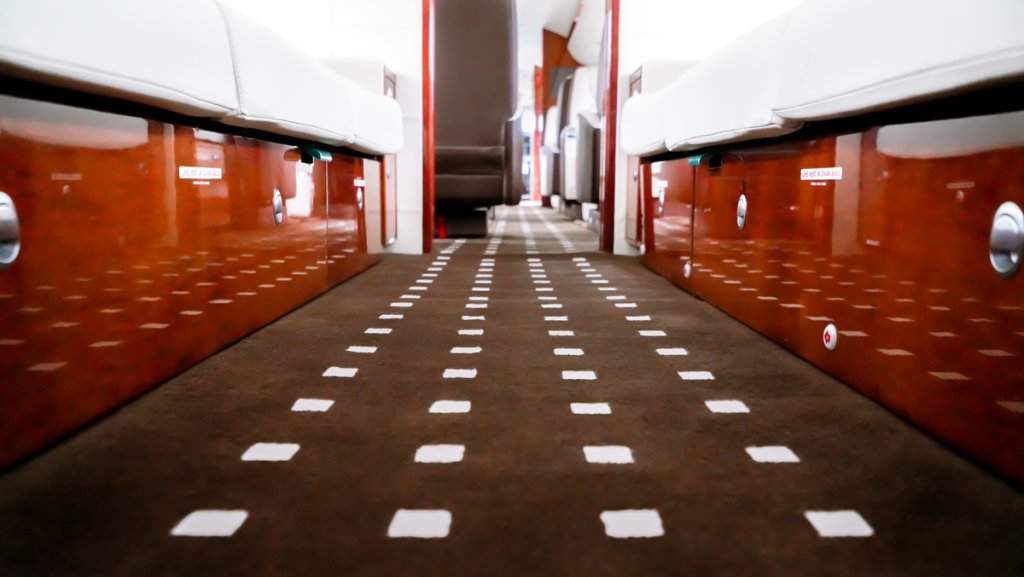A sleek and up-to-date aircraft interior starts with a vision. Whether you already have an interior design in mind or want to explore the possibilities, there are numerous features and upgrades to consider when designing your private or corporate jet’s interior.
Now, where to begin? In this article, we identify the key factors to consider when starting the aircraft interior design process that will assist you in clarifying your project goals.

When to Start Designing Your Aircraft Interior?
We recommend beginning the aircraft interior design process 6 months to 1 year before your planned refurbishment. How long the process will take depends on your level of specification, such as refurbishing a few features or getting a complete interior makeover. Timing can also depend on how quickly designs are finalized and materials are obtained.
When to Schedule Your Aircraft Interior Refurbishment?
Consider scheduling your aircraft interior refurbishment during a major inspection when cabin interiors are removed for maintenance. This is an ideal time for upgrading cabin seating, cabinetry, cabin management systems (CMS), connectivity, and sound systems.
What is the Length of Downtime?
A complete interior refurbishment takes 6 to 8 weeks on average. Downtime can vary depending on the aircraft size, refurbishment level (e.g., add-ons or customization beyond standard options), and lead times for some materials.
What to Bring to Your First Meeting with a Designer?
To help clarify your initial ideas with an aircraft interior designer or design team, bring photos of your favorite interior features to your meetings, if possible. These may include interior features from another aircraft, sports car, or yacht that inspired your aircraft refurbishment.
Designers will then provide color palettes and material samples to review and should be able to suggest further options or alternatives as needed. Designers can generate digital renderings of your aircraft interior that most closely align with your vision.

Key Factors for Aircraft Interior Design
Dreaming about exquisite materials and modern upgrades can be exciting, but first, you need to consider some key factors to determine your operational goals.
What is the Aircraft’s Purpose?
An important initial question is understanding the aircraft’s function. Is it for charter, business, or private use? Each of these functions provides different interior design options. For instance, a charter aircraft may see more foot traffic and general use, requiring more durable carpets and upholstery. In comparison, a private jet used by just you and your family will have more luxurious options available.
For business aircraft, consider how your passengers will utilize the space. Will they be working on their laptops? If so, they will require high-speed internet and conveniently located tables. If they regularly commute to work in the aircraft, you may opt for more durable and less lavish materials to maintain the aircraft’s interior appearance over time.
What’s Your Budget?
Aircraft interior refurbishment options are practically limitless – and so are the prices. Identifying a budget early in the process may assist in establishing parameters for interior upgrade options.
Also, consider identifying which features, upgrades, and materials are the most important to you. Your designer or design team may be able to negotiate between the items you want and those that are less necessary so you can receive the cabin interior that reflects your vision while still meeting your budget.
What are Your Future Plans for the Aircraft?
Interior designers may ask how long you intend to keep the aircraft. If you plan to sell the aircraft in the next few years, consider interior refurbishments and designs that are less trendy and more neutral, so they will not appear as dated over time.

Start with the Seats
We recommend starting with the main focal point of the interior, where you and your passengers will be spending the majority of the time: the cabin seats.
You can choose from various fabrics and leathers, single or two-tone leather styles, stitching types and colored thread, seat belt color, and seatbelt buckle plating. If your aircraft features 9G seat frames, you may also be able to redesign the seat style and foam builds.
Your choices when designing your cabin seats will influence other interior refurbishment options. For example, the seat upholstery should complement the carpet and sidewalls, thread color can be used as an accent throughout the cabin, and the seatbelt buckle plate can be used on cabinetry hardware.
Aircraft Interior Design Options
Aircraft interior refurbishment and upgrade options generally include:
- Seat Design, Foam Builds & Upholstery
- Carpet Replacement
- Cabinetry
- Repair and recovery of Sidewall Panels, Headliners, Ceiling Panels, Lower Sidewall & Dado Panels
- Window Surrounds
- Interior Paint
- Hydro-dipping or refurbishment of traditional wood interiors
- Wi-Fi Connectivity
- In-Flight Entertainment (IFE) System Integration
- Acoustic Packages & Soundproofing
- Cabin LED Lighting Installation
- Full Cabin Reconfigurations & Alterations

Achieve Aircraft Interior Design Goals
By identifying the key factors and options during the early stages of the interior design process, you’ll save time and be able to accurately articulate your cabin refurbishment plan with your interior designer. As you progress through the process, interior designers should be willing to disclose additional options and alternatives to create a fully customized interior based on your aviation needs and vision.

















